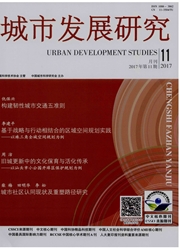

 中文摘要:
中文摘要:
本文综合运用密度表面、空间聚类、多元逐步回归等方法,探讨了我国生态城市建设的时空演化格局及其驱动机理。主要结论如下:(1)对我国360个拟建生态城市的时空演化格局分析表明,从时间维度上讲,我国生态城市建设的空间展布经历了一个由离散——聚集——离散的倒U型演化过程;从空间维度上看,我国拟建生态城市的空间分布显示出较强的地域分异特征和聚集现象;从分布密度上讲,开展生态城市建设的数量与经济发达程度之间具有较强的相关性。(2)对我国生态城市建设驱动机理的分析表明,城市规模、城市经济状况是开展生态城市建设的主要影响因素;城市生态环境状况对于开展生态城市建设的影响比较微弱。
 英文摘要:
英文摘要:
In order to the better understanding and judgment of China′s eco-city construction activities in present,and grasp the process and internal mechanism of eco-city construction,this paper has collected a lot of eco-city construction cases in China,and analyzed the spatial-temporal pattern and its driving mechanism of eco-city construction in China by means of density surface,spatial cluster,and the multivarlate stepwise regression analysis method.The main conclusions are as follows:(1) The spatial-temporal pattern analysis of the 360 proposed ecological cities in China shows that,from the aspect of temporal,the space distribution of those proposed ecological cities in China experienced an inverted U-shaped evolutionary process of scatter-cluster-scatter;from the aspect of spatial,the space distribution of those cities showed a strongly geographical differentiation and aggregation;from the aspect of distribution density,the number of cities to carry out eco-city construction has a positive correlation with the degree of economic development.(2) The driving force analysis of the 360 proposed ecological cities in China shows that,city size and city economy are the main driving forces to carry out eco-city construction,while the city′s ecological environment has little impacts on eco-city construction.
 同期刊论文项目
同期刊论文项目
 同项目期刊论文
同项目期刊论文
 期刊信息
期刊信息
